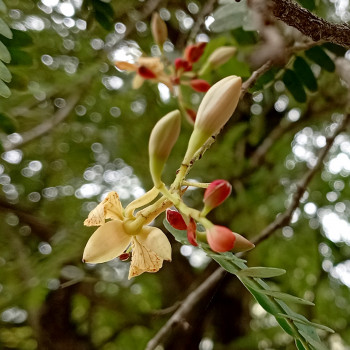Tamarind

Scientific Name :
Tamarindus indica L.
Synonym(s) :
Tamarindus officinalis Hook.
Local/Common name(s) :
Valanpuli, Tamarind
Family :
Fabaceae
Habit :
Tree
Flowering/Fruiting Time :
September-April
Habitat :
Cultivated
Endemic :
No
Status (IUCN) :
Least concern (LC)
Distribution :
Native of Tropical Africa; introduced and widely grown in India and other parts of tropics
Nativity :
Exotic
Uses :
Medicine, Food
Description (Morphology) :
Trees, to 20 m high, bark brown to brownish-black, rough with vertical fissures; branchlets warty, tomentose. Leaves paripinnate, alternate, leaflets 20-34, opposite, sessile, 1.5-4 x 0.4-1.3 cm, oblong, apex obtuse, base unequal, margin entire, glabrous, chartaceous; stipules lateral, minute, cauducous; rachis 8-13 cm long, slender, glabrous, pulvinate; lateral nerves 10-15 pairs, pinnate, slender, obscure, looped at the margin forming intramarginal nerve; intercostae reticulate, obscure. Flowers bisexual, 1 cm across, yellow with reddish-pink dots, in lax terminal racemes; bracts and bracteoles ovate-oblong, coloured, cauducous; pedicels upto 5 mm. Calyx tube narrowly turbinate, lined by disc; lobes 4, subequal, oblong, imbricate. Petals 3, outer one, 1 x 0.3 cm, rolled up, pink dotted, lateral 2, 1-1.5 x 0.7-1 cm, clawed, subequal, oblong-lanceolate, lower pair scaly. Stamens 9 monadelphous, only 3 fertile, others reduced to bristle, base pubescent; anthers versatile; ovary half inferior, stipitate, adnate to the disc, ovules many; style attenuate, tomentose; stigma globose. Fruit a pod 10-15 x 1-2 cm, oblong, fruit wall crustaceous, mesocarp pulpy, endocarp septate, leathery, indehiscent; seeds 3-8 or more, obovoid-orbicular, compressed, brown.



